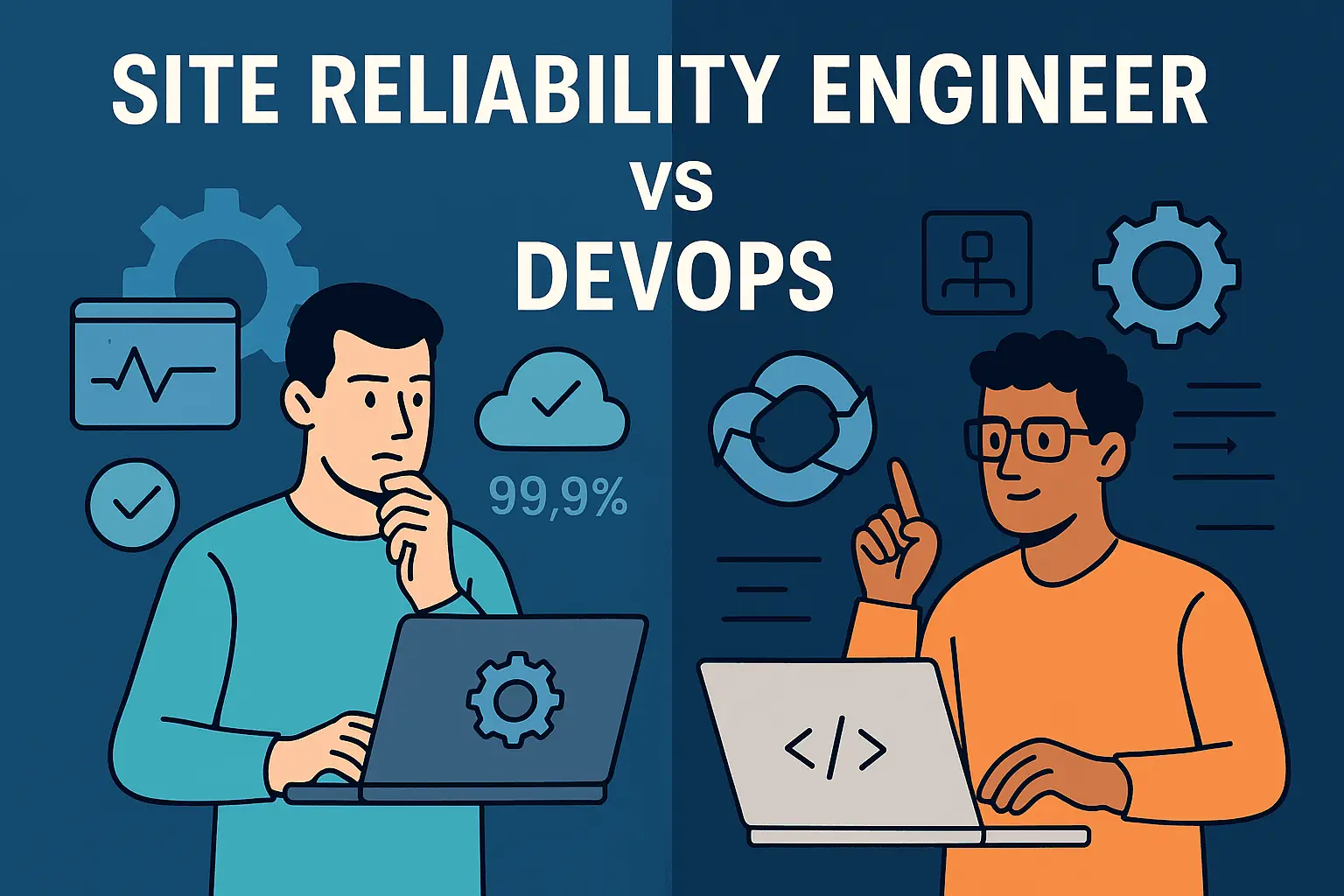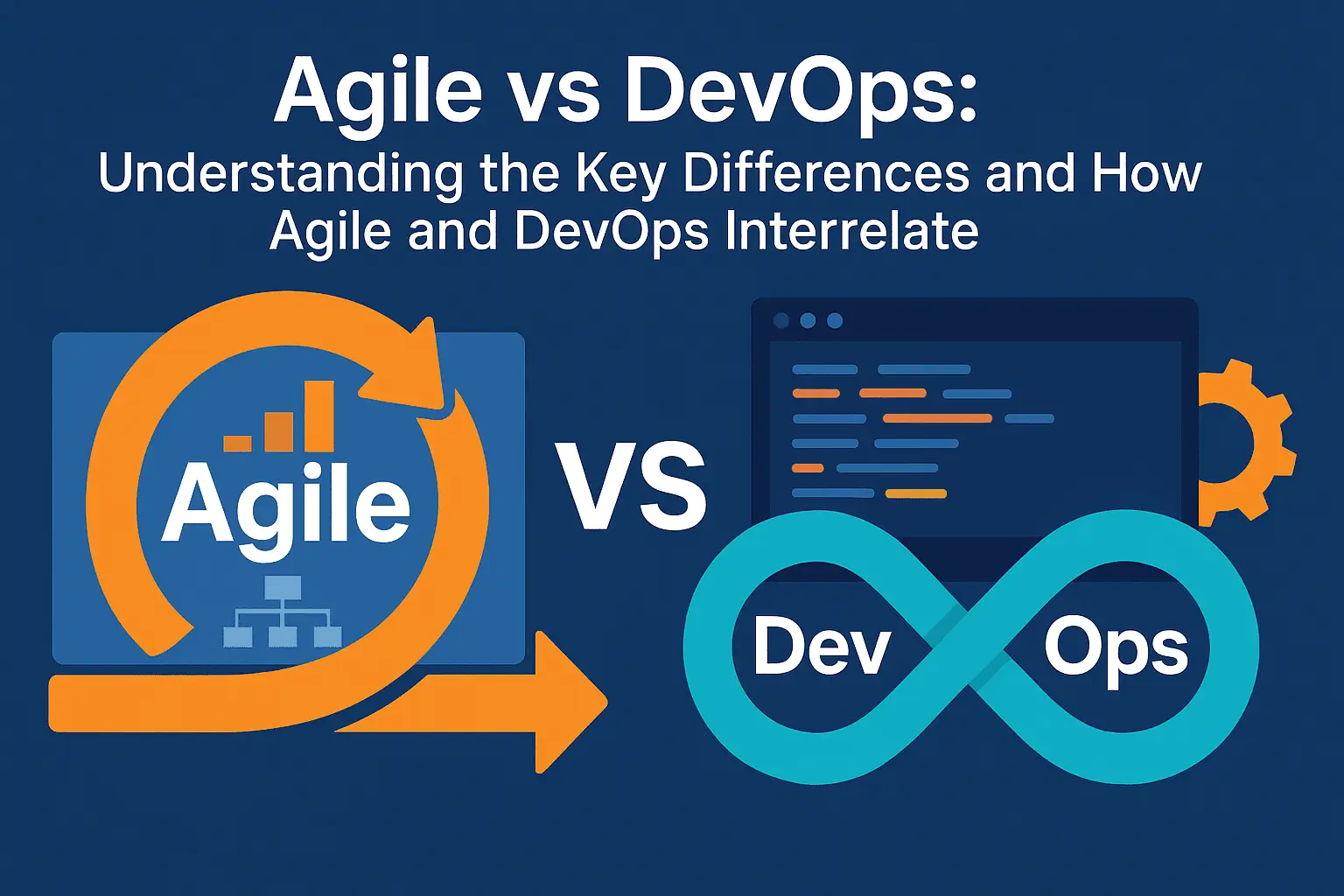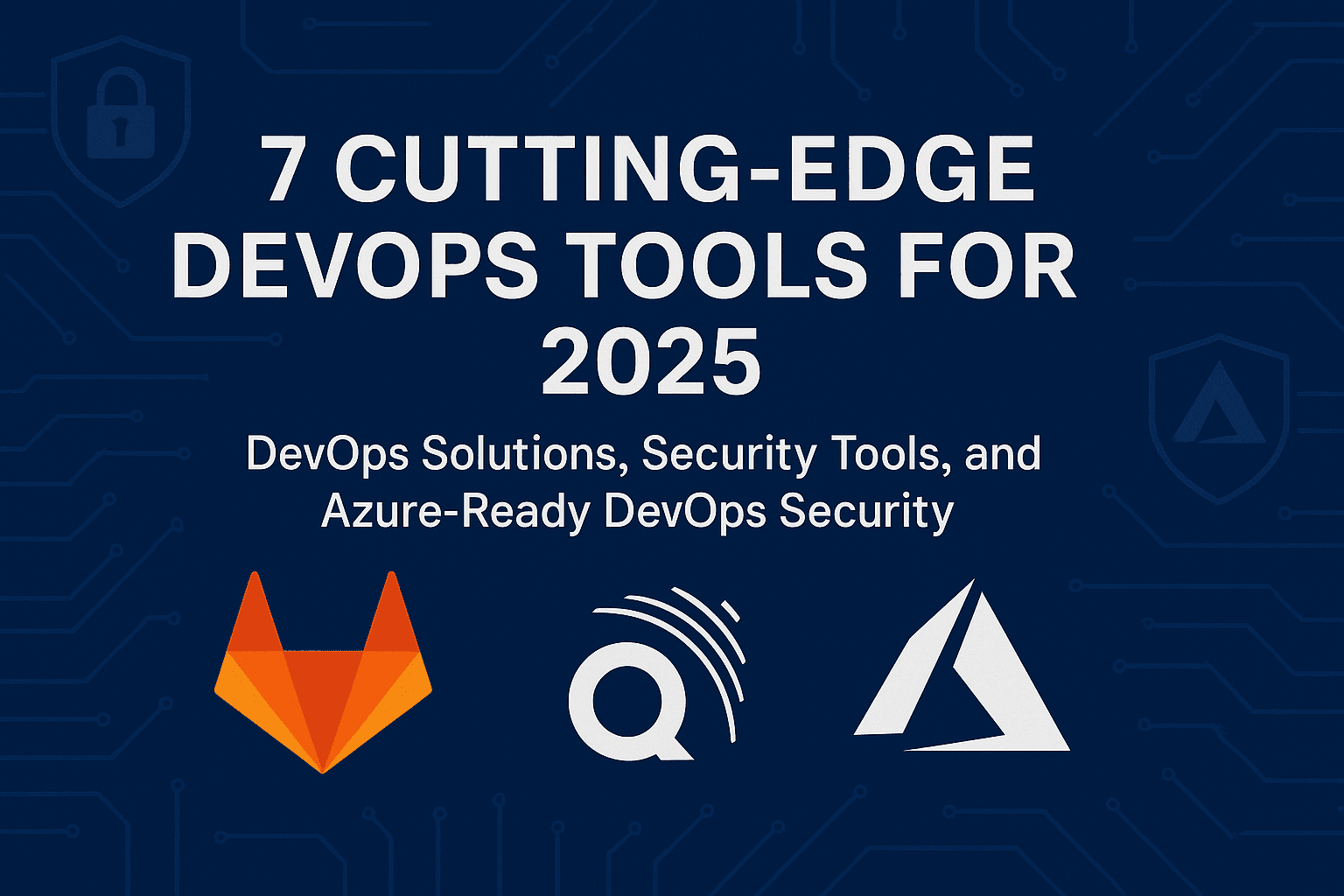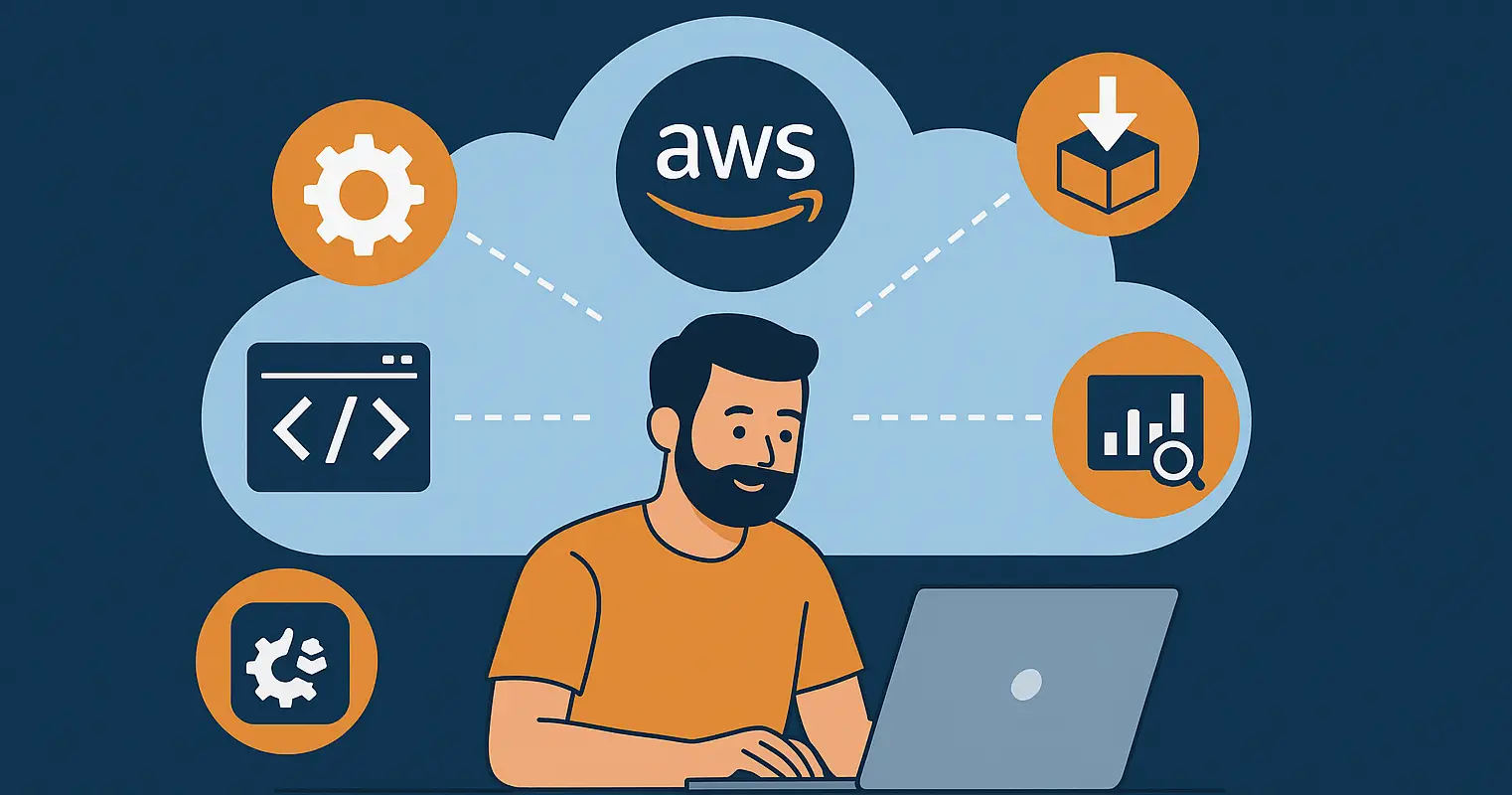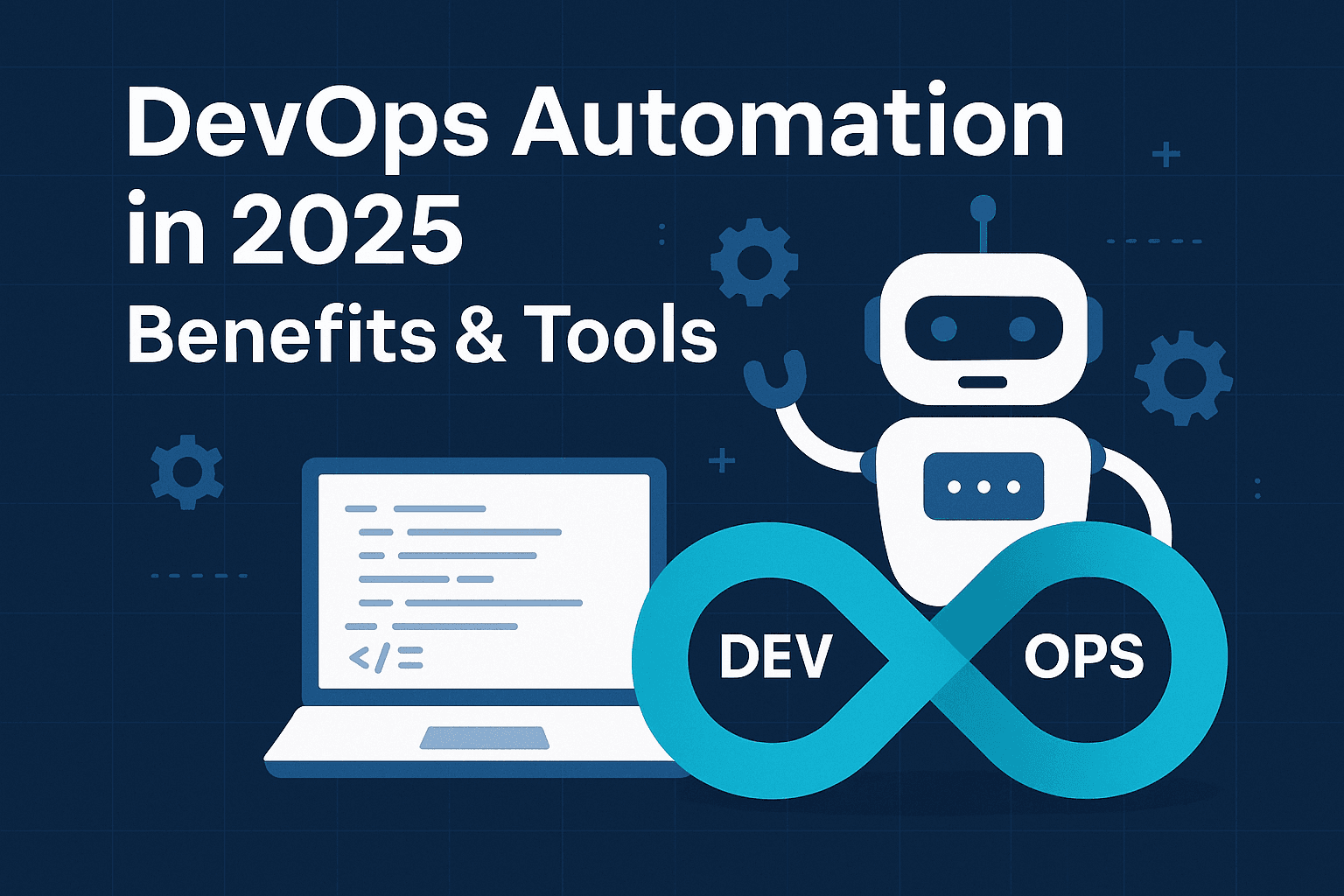So you’ve heard the terms DevOps and Site Reliability Engineering (SRE) tossed around, but you’re not totally clear on what they actually do or how they’re different. Don’t sweat it—I was confused too.
Let’s break this down together in plain English.
What Is DevOps and How Does a DevOps Team Work?
Imagine developers (the folks who build apps) and operations (the folks who keep servers running) used to work in totally separate silos. They’d throw code over the wall and hope it worked. DevOps flips this. It’s a cultural shift where these teams merge into one squad focused on speed, collaboration, and automation.
A DevOps team builds, tests, deploys, and monitors software together. They use tools like Jenkins for automation and Docker/Kubernetes for container management to ship code faster (continuous delivery). For example, if a developer writes code, a DevOps engineer might automate its testing and deployment, then monitor it in production—all in one seamless flow. Their goal? Faster releases without chaos.
But it’s more than just speeding up the process. DevOps is about making software delivery more predictable, reducing manual errors, and improving communication. It’s about creating a unified culture where development and operations are fully integrated, rather than working in isolation.
For DevOps to work, teams have to automate processes wherever possible. Automation tools, CI/CD pipelines, and infrastructure as code (IaC) are core to the DevOps culture. By using these tools, DevOps engineers can deploy changes more frequently, improve application quality, and minimize human error. A major aspect of DevOps is to remove any friction between dev and ops, making the whole software lifecycle—developing, testing, deploying, and maintaining—smoother and more efficient.
What Is SRE and What Does a Site Reliability Engineer Do?
Now, meet the Site Reliability Engineer (SRE). Google invented this role in 2003 to solve a headache: “How do we keep massive systems running 24/7?”
SREs apply software engineering principles to operational tasks. Their goal is to create scalable and highly reliable software systems. Unlike traditional ops teams that focus on keeping systems up and running, SREs leverage automation and software engineering to solve operational problems.
An SRE team uses software engineering skills to fix operations problems. Think of them as system doctors. They:
- Automate manual tasks (like restarting servers).
- Set reliability targets (e.g., “99.9% uptime”).
- Jump on outages (incident response) and do post-mortems to prevent repeats.
Their mantra is “Eliminate toil, embrace automation,” and they are constantly looking for ways to automate the tedious and repetitive tasks that slow down operations. For example, if a website crashes, SREs don’t just reboot it—they build a tool to auto-fix it next time. They also work to ensure that systems are designed to recover automatically after failures, improving system resilience and minimizing downtime.
SREs don’t just handle system failures; they also predict and prevent them. They use Service Level Indicators (SLIs) and Service Level Objectives (SLOs) to track the health of the systems, ensuring that performance and reliability stay within acceptable thresholds. It’s all about minimizing risk by setting realistic, measurable reliability targets and then working relentlessly to meet those targets.
DevOps and SRE – Key Differences Between SRE and DevOps
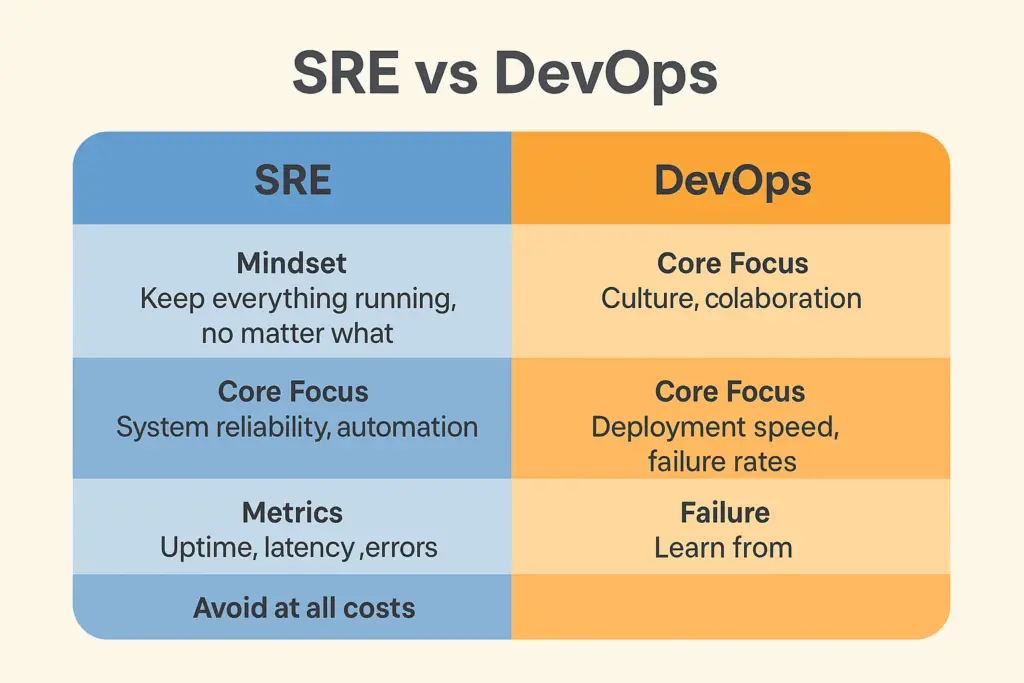
Let’s clear the fog and take a deeper look at the differences between DevOps and SRE. Both share common goals (better software! happier users!), but their approach, focus, and tactics vary significantly.
Here’s a detailed breakdown of how they differ:
| Aspect | DevOps | SRE |
| Mindset | “Ship features fast, but safely.” The focus is on increasing the speed of software delivery while maintaining safety and quality. The idea is to break down barriers between development and operations teams to encourage faster, more frequent releases. | “Keep everything running, no matter what.” The SRE mindset is built around ensuring reliability, stability, and uptime at all costs. They prioritize maintaining a system that works continuously and performs optimally, even under heavy stress or when things go wrong. |
| Core Focus | DevOps emphasizes culture, collaboration, and automating the continuous integration and continuous delivery (CI/CD) pipelines. It aims to create a seamless workflow where development and operations are in constant communication to speed up the process of building, testing, and deploying software. | SRE’s core focus is on system reliability, automation, and managing error budgets (SLOs—Service Level Objectives). Their mission is to make sure the systems stay running reliably over time, and they handle the operational side with a strong focus on preventing outages, reducing downtime, and optimizing systems for resilience. |
| Metrics | DevOps measures success through deployment speed, failure rates, and other performance metrics such as lead time for changes and the mean time to recovery (MTTR). Key metrics are often tracked by the DORA (DevOps Research and Assessment) framework, which measures the speed and reliability of software delivery. | SRE, on the other hand, measures success based on uptime, latency, and errors. They use Service Level Indicators (SLIs) and Service Level Objectives (SLOs) to define, track, and measure system reliability, focusing on maintaining agreed-upon performance targets for system uptime and performance. |
| Failure | In DevOps, failure is seen as an opportunity to learn and iterate. They embrace a blameless culture, encouraging the team to experiment, fail fast, and improve. DevOps teams learn from mistakes and continuously improve their processes. | In SRE, failure is something to avoid at all costs. They’re focused on meeting Service Level Agreements (SLAs) and minimizing system downtime or failures. While SREs also learn from incidents, their proactive approach involves setting up error budgets, which allow a certain level of failure but prioritize preventing major incidents that could affect user experience. |
| Team Structure | In DevOps, teams often have mixed roles that combine development and operations functions. The aim is to break down the silos between these traditionally separate teams and create a single unified team responsible for the entire lifecycle of the application, from development to deployment and monitoring. | SRE teams are typically composed of specialized software engineers who focus specifically on operations. While DevOps teams are more about integrating development and operations, SRE teams bring a deeper focus on software engineering in managing complex systems and automating operations tasks to ensure reliability. |
Similarities Between SRE and DevOps Engineers
Despite these differences, DevOps and SRE are more like cousins at a family reunion—similar in many ways, with some notable distinctions:
- Automation obsession: Both DevOps and SRE share a deep focus on automation. DevOps focuses on automating the testing and deployment pipeline, making sure that code is shipped efficiently. SRE automates everything from incident fixes to proactive system maintenance, aiming to eliminate manual intervention and reduce human error.
- Tool overlap: The tools used by both DevOps and SRE teams often overlap. Both teams leverage tools like Kubernetes for container orchestration, Terraform for infrastructure provisioning, and Prometheus for monitoring. While the focus and application of these tools may differ slightly, both teams rely on them to help streamline processes and improve system performance.
- Shared goals: Ultimately, both DevOps and SRE aim for the same shared objectives: reliable systems, happy users, and a culture of no finger-pointing when things break. Both strive to ensure that software is built, deployed, and maintained with a focus on stability, performance, and user satisfaction.
- CI/CD love: Continuous Integration and Continuous Deployment (CI/CD) are at the heart of both DevOps and SRE practices. Both teams rely on continuous pipelines to push updates safely and frequently, allowing for rapid, yet stable, releases.
As one Google engineer puts it: “SRE is how you do DevOps.” This highlights the complementary nature of these two practices, showing that SRE acts as the backbone to ensure that DevOps’ rapid delivery process doesn’t compromise system stability.
DevOps or SRE – Which One Is Right for Your Organization?
Wondering whether to hire a DevOps engineer or an SRE team? Here’s my take:
Pick DevOps if:
- You’re struggling with slow releases or team silos.
- Your priority is shipping features faster (startups, agile teams).
Pick SRE if:
- You run large-scale systems (e.g., e-commerce, cloud services).
- Downtime costs you $$$ (they’ll guard uptime like hawks).
Big truth? You might need both. DevOps builds the rocket; SRE ensures it doesn’t explode.
SRE Tools vs DevOps Tools – Understanding the Tech Stack
Tools aren’t exclusive to either camp, but here’s where they typically overlap and diverge:
| Task | DevOps Tools | SRE Tools |
| Automation | Jenkins, GitLab CI | Ansible, Chef |
| Monitoring | Splunk, Datadog | Prometheus, Grafana |
| Infrastructure | Terraform, AWS CDK | Kubernetes, Crossplane |
| Incident Response | PagerDuty, Slack | xMatters, Stackdriver |
Automation
Both DevOps and SRE rely heavily on automation to streamline repetitive tasks, reduce errors, and ensure consistency across environments. Automation helps in eliminating manual processes, which in turn enhances efficiency and reduces the risk of human error.
- DevOps Tools:
- Jenkins and GitLab CI are the most commonly used tools in DevOps for automating continuous integration and continuous deployment (CI/CD) pipelines. They help automate the process of building, testing, and deploying code from development to production. Jenkins is a widely adopted open-source tool that integrates with a variety of plugins and tools for automating the software delivery lifecycle. GitLab CI, part of the GitLab platform, focuses on automating the entire DevOps lifecycle, offering version control, CI/CD, and monitoring in one tool.
- Jenkins and GitLab CI are the most commonly used tools in DevOps for automating continuous integration and continuous deployment (CI/CD) pipelines. They help automate the process of building, testing, and deploying code from development to production. Jenkins is a widely adopted open-source tool that integrates with a variety of plugins and tools for automating the software delivery lifecycle. GitLab CI, part of the GitLab platform, focuses on automating the entire DevOps lifecycle, offering version control, CI/CD, and monitoring in one tool.
- SRE Tools:
- Ansible and Chef are automation tools commonly used by SRE teams to manage infrastructure and configuration at scale. These tools are particularly valuable in automating the deployment of complex systems, infrastructure provisioning, and ensuring system consistency across environments. Ansible is known for its simplicity and agentless approach, while Chef is known for more advanced use cases and configurations in large-scale environments. Both tools allow SRE teams to automate and orchestrate tasks that would otherwise be manual and prone to error.
- Ansible and Chef are automation tools commonly used by SRE teams to manage infrastructure and configuration at scale. These tools are particularly valuable in automating the deployment of complex systems, infrastructure provisioning, and ensuring system consistency across environments. Ansible is known for its simplicity and agentless approach, while Chef is known for more advanced use cases and configurations in large-scale environments. Both tools allow SRE teams to automate and orchestrate tasks that would otherwise be manual and prone to error.
Monitoring
Monitoring is one of the most critical tasks for both DevOps and SRE. However, while DevOps focuses on ensuring fast and continuous releases, SRE teams prioritize system health and availability, often dealing with proactive monitoring of key performance indicators (KPIs) like uptime, latency, and error rates.
- DevOps Tools:
- Splunk and Datadog are frequently used in the DevOps world to monitor application performance and logs. Splunk is used to collect and analyze large volumes of machine-generated data (logs, metrics, and events), making it easier for DevOps teams to diagnose issues and identify trends during development and post-deployment. Datadog, on the other hand, is a SaaS-based monitoring platform that provides end-to-end visibility into applications, servers, databases, and cloud infrastructure. It’s especially useful for monitoring the health of microservices and containerized applications in real-time.
- Splunk and Datadog are frequently used in the DevOps world to monitor application performance and logs. Splunk is used to collect and analyze large volumes of machine-generated data (logs, metrics, and events), making it easier for DevOps teams to diagnose issues and identify trends during development and post-deployment. Datadog, on the other hand, is a SaaS-based monitoring platform that provides end-to-end visibility into applications, servers, databases, and cloud infrastructure. It’s especially useful for monitoring the health of microservices and containerized applications in real-time.
- SRE Tools:
- Prometheus and Grafana are primary tools for monitoring in SRE. Prometheus is an open-source monitoring system designed for reliability, with a focus on providing real-time metrics and time-series data collection. It uses a pull model to retrieve metrics from configured endpoints at regular intervals and provides powerful querying capabilities through its PromQL language. Grafana is used in conjunction with Prometheus to visualize these metrics, creating dashboards and alerts to keep an eye on system health. SRE teams use Prometheus and Grafana to monitor service-level indicators (SLIs), service-level objectives (SLOs), and overall system performance, ensuring systems meet the predefined reliability targets.
- Prometheus and Grafana are primary tools for monitoring in SRE. Prometheus is an open-source monitoring system designed for reliability, with a focus on providing real-time metrics and time-series data collection. It uses a pull model to retrieve metrics from configured endpoints at regular intervals and provides powerful querying capabilities through its PromQL language. Grafana is used in conjunction with Prometheus to visualize these metrics, creating dashboards and alerts to keep an eye on system health. SRE teams use Prometheus and Grafana to monitor service-level indicators (SLIs), service-level objectives (SLOs), and overall system performance, ensuring systems meet the predefined reliability targets.
Infrastructure
Infrastructure management is crucial for both DevOps and SRE. However, while DevOps focuses on automating the deployment pipeline and handling infrastructure as code (IaC), SREs take it a step further by ensuring the infrastructure can scale to handle increased loads and remain highly available.
- DevOps Tools:
- Terraform and AWS CDK are widely used by DevOps teams to automate infrastructure provisioning and management. Terraform is an open-source IaC tool that allows teams to define and provision data center infrastructure using configuration files, making it easy to deploy and manage infrastructure across multiple cloud providers. The AWS Cloud Development Kit (CDK) is a higher-level tool that allows teams to define cloud infrastructure using programming languages (like TypeScript, Python, or Java) rather than declarative configuration files. Both tools allow DevOps teams to treat infrastructure as code, making it versionable, reproducible, and easy to scale.
- Terraform and AWS CDK are widely used by DevOps teams to automate infrastructure provisioning and management. Terraform is an open-source IaC tool that allows teams to define and provision data center infrastructure using configuration files, making it easy to deploy and manage infrastructure across multiple cloud providers. The AWS Cloud Development Kit (CDK) is a higher-level tool that allows teams to define cloud infrastructure using programming languages (like TypeScript, Python, or Java) rather than declarative configuration files. Both tools allow DevOps teams to treat infrastructure as code, making it versionable, reproducible, and easy to scale.
- SRE Tools:
- Kubernetes and Crossplane are tools frequently used by SREs for managing infrastructure at scale. Kubernetes is an open-source container orchestration platform designed to automate the deployment, scaling, and management of containerized applications. SREs use Kubernetes to ensure that systems are running efficiently, automatically scaling up or down based on demand, and recovering from failures without human intervention. Crossplane, a newer entrant, is an open-source infrastructure management platform that allows SREs to manage and provision cloud infrastructure with a focus on abstraction and flexibility. Crossplane integrates with multiple cloud providers, giving teams the ability to manage both their application workloads and infrastructure in a unified way.
- Kubernetes and Crossplane are tools frequently used by SREs for managing infrastructure at scale. Kubernetes is an open-source container orchestration platform designed to automate the deployment, scaling, and management of containerized applications. SREs use Kubernetes to ensure that systems are running efficiently, automatically scaling up or down based on demand, and recovering from failures without human intervention. Crossplane, a newer entrant, is an open-source infrastructure management platform that allows SREs to manage and provision cloud infrastructure with a focus on abstraction and flexibility. Crossplane integrates with multiple cloud providers, giving teams the ability to manage both their application workloads and infrastructure in a unified way.
Incident Response
Incident response is an area where both DevOps and SRE need to be highly skilled, as any downtime or failure can negatively impact users. However, SREs often take the lead in managing incidents, especially when it comes to large-scale outages and ensuring that systems are restored quickly and reliably.
- DevOps Tools:
- PagerDuty and Slack are frequently used in the DevOps space for incident management and communication. PagerDuty is an incident response platform that integrates with monitoring tools and automatically triggers alerts to the appropriate team members when issues arise. It allows for quick escalation and collaboration to resolve incidents.
- Slack, on the other hand, is commonly used for real-time communication among teams during an incident. It’s often integrated with monitoring tools, so teams can discuss issues as they occur, track progress in real time, and quickly share information.
- PagerDuty and Slack are frequently used in the DevOps space for incident management and communication. PagerDuty is an incident response platform that integrates with monitoring tools and automatically triggers alerts to the appropriate team members when issues arise. It allows for quick escalation and collaboration to resolve incidents.
- SRE Tools:
xMatters and Stackdriver are tools that play a critical role in incident management for SRE teams. xMatters provides real-time collaboration and automated workflows to streamline incident resolution. It integrates with monitoring systems to notify the right team members about incidents, ensuring quick action and escalation. Stackdriver, now integrated into Google Cloud Operations Suite, offers monitoring, logging, and incident management features for cloud-based systems. It helps SRE teams quickly identify the root cause of incidents and resolve them by offering deep insights into system performance, logs, and metrics.
Conclusion
DevOps and SRE aren’t rivals—they’re teammates. DevOps speeds up development; SRE ensures that speed doesn’t break things. If you’re just starting, adopt DevOps practices first. When scale bites, bring in SREs to keep the ship steady.

